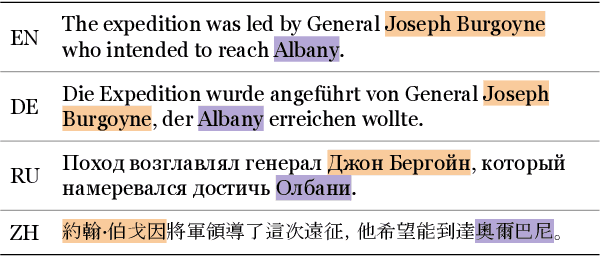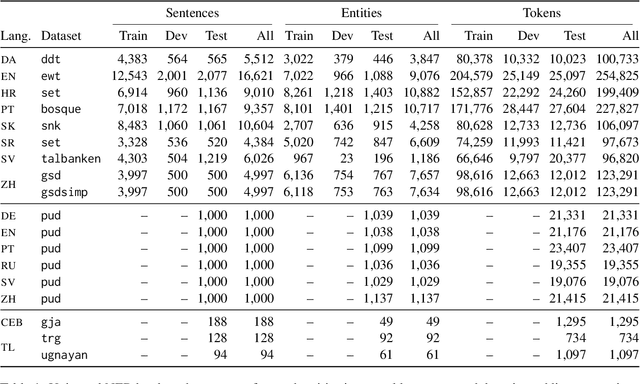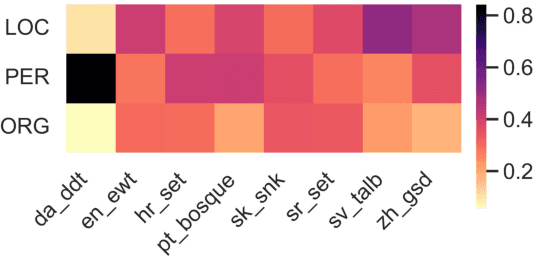Nikola Ljubešić
CLASSLA-Express: a Train of CLARIN.SI Workshops on Language Resources and Tools with Easily Expanding Route
Dec 02, 2024Abstract:This paper introduces the CLASSLA-Express workshop series as an innovative approach to disseminating linguistic resources and infrastructure provided by the CLASSLA Knowledge Centre for South Slavic languages and the Slovenian CLARIN.SI infrastructure. The workshop series employs two key strategies: (1) conducting workshops directly in countries with interested audiences, and (2) designing the series for easy expansion to new venues. The first iteration of the CLASSLA-Express workshop series encompasses 6 workshops in 5 countries. Its goal is to share knowledge on the use of corpus querying tools, as well as the recently-released CLASSLA-web corpora - the largest general corpora for South Slavic languages. In the paper, we present the design of the workshop series, its current scope and the effortless extensions of the workshop to new venues that are already in sight.
* Published in CLARIN Annual Conference Proceedings 2024 (https://www.clarin.eu/sites/default/files/CLARIN2024_ConferenceProceedings_final.pdf)
LLM Teacher-Student Framework for Text Classification With No Manually Annotated Data: A Case Study in IPTC News Topic Classification
Nov 29, 2024Abstract:With the ever-increasing number of news stories available online, classifying them by topic, regardless of the language they are written in, has become crucial for enhancing readers' access to relevant content. To address this challenge, we propose a teacher-student framework based on large language models (LLMs) for developing multilingual news classification models of reasonable size with no need for manual data annotation. The framework employs a Generative Pretrained Transformer (GPT) model as the teacher model to develop an IPTC Media Topic training dataset through automatic annotation of news articles in Slovenian, Croatian, Greek, and Catalan. The teacher model exhibits a high zero-shot performance on all four languages. Its agreement with human annotators is comparable to that between the human annotators themselves. To mitigate the computational limitations associated with the requirement of processing millions of texts daily, smaller BERT-like student models are fine-tuned on the GPT-annotated dataset. These student models achieve high performance comparable to the teacher model. Furthermore, we explore the impact of the training data size on the performance of the student models and investigate their monolingual, multilingual and zero-shot cross-lingual capabilities. The findings indicate that student models can achieve high performance with a relatively small number of training instances, and demonstrate strong zero-shot cross-lingual abilities. Finally, we publish the best-performing news topic classifier, enabling multilingual classification with the top-level categories of the IPTC Media Topic schema.
Multilingual Power and Ideology Identification in the Parliament: a Reference Dataset and Simple Baselines
May 12, 2024Abstract:We introduce a dataset on political orientation and power position identification. The dataset is derived from ParlaMint, a set of comparable corpora of transcribed parliamentary speeches from 29 national and regional parliaments. We introduce the dataset, provide the reasoning behind some of the choices during its creation, present statistics on the dataset, and, using a simple classifier, some baseline results on predicting political orientation on the left-to-right axis, and on power position identification, i.e., distinguishing between the speeches delivered by governing coalition party members from those of opposition party members.
Language Models on a Diet: Cost-Efficient Development of Encoders for Closely-Related Languages via Additional Pretraining
Apr 08, 2024Abstract:The world of language models is going through turbulent times, better and ever larger models are coming out at an unprecedented speed. However, we argue that, especially for the scientific community, encoder models of up to 1 billion parameters are still very much needed, their primary usage being in enriching large collections of data with metadata necessary for downstream research. We investigate the best way to ensure the existence of such encoder models on the set of very closely related languages - Croatian, Serbian, Bosnian and Montenegrin, by setting up a diverse benchmark for these languages, and comparing the trained-from-scratch models with the new models constructed via additional pretraining of existing multilingual models. We show that comparable performance to dedicated from-scratch models can be obtained by additionally pretraining available multilingual models even with a limited amount of computation. We also show that neighboring languages, in our case Slovenian, can be included in the additional pretraining with little to no loss in the performance of the final model.
CLASSLA-web: Comparable Web Corpora of South Slavic Languages Enriched with Linguistic and Genre Annotation
Mar 26, 2024Abstract:This paper presents a collection of highly comparable web corpora of Slovenian, Croatian, Bosnian, Montenegrin, Serbian, Macedonian, and Bulgarian, covering thereby the whole spectrum of official languages in the South Slavic language space. The collection of these corpora comprises a total of 13 billion tokens of texts from 26 million documents. The comparability of the corpora is ensured by a comparable crawling setup and the usage of identical crawling and post-processing technology. All the corpora were linguistically annotated with the state-of-the-art CLASSLA-Stanza linguistic processing pipeline, and enriched with document-level genre information via the Transformer-based multilingual X-GENRE classifier, which further enhances comparability at the level of linguistic annotation and metadata enrichment. The genre-focused analysis of the resulting corpora shows a rather consistent distribution of genres throughout the seven corpora, with variations in the most prominent genre categories being well-explained by the economic strength of each language community. A comparison of the distribution of genre categories across the corpora indicates that web corpora from less developed countries primarily consist of news articles. Conversely, web corpora from economically more developed countries exhibit a smaller proportion of news content, with a greater presence of promotional and opinionated texts.
Do Language Models Care About Text Quality? Evaluating Web-Crawled Corpora Across 11 Languages
Mar 13, 2024Abstract:Large, curated, web-crawled corpora play a vital role in training language models (LMs). They form the lion's share of the training data in virtually all recent LMs, such as the well-known GPT, LLaMA and XLM-RoBERTa models. However, despite this importance, relatively little attention has been given to the quality of these corpora. In this paper, we compare four of the currently most relevant large, web-crawled corpora (CC100, MaCoCu, mC4 and OSCAR) across eleven lower-resourced European languages. Our approach is two-fold: first, we perform an intrinsic evaluation by performing a human evaluation of the quality of samples taken from different corpora; then, we assess the practical impact of the qualitative differences by training specific LMs on each of the corpora and evaluating their performance on downstream tasks. We find that there are clear differences in quality of the corpora, with MaCoCu and OSCAR obtaining the best results. However, during the extrinsic evaluation, we actually find that the CC100 corpus achieves the highest scores. We conclude that, in our experiments, the quality of the web-crawled corpora does not seem to play a significant role when training LMs.
Universal NER: A Gold-Standard Multilingual Named Entity Recognition Benchmark
Nov 15, 2023



Abstract:We introduce Universal NER (UNER), an open, community-driven project to develop gold-standard NER benchmarks in many languages. The overarching goal of UNER is to provide high-quality, cross-lingually consistent annotations to facilitate and standardize multilingual NER research. UNER v1 contains 18 datasets annotated with named entities in a cross-lingual consistent schema across 12 diverse languages. In this paper, we detail the dataset creation and composition of UNER; we also provide initial modeling baselines on both in-language and cross-lingual learning settings. We release the data, code, and fitted models to the public.
The ParlaSent multilingual training dataset for sentiment identification in parliamentary proceedings
Sep 18, 2023Abstract:Sentiments inherently drive politics. How we receive and process information plays an essential role in political decision-making, shaping our judgment with strategic consequences both on the level of legislators and the masses. If sentiment plays such an important role in politics, how can we study and measure it systematically? The paper presents a new dataset of sentiment-annotated sentences, which are used in a series of experiments focused on training a robust sentiment classifier for parliamentary proceedings. The paper also introduces the first domain-specific LLM for political science applications additionally pre-trained on 1.72 billion domain-specific words from proceedings of 27 European parliaments. We present experiments demonstrating how the additional pre-training of LLM on parliamentary data can significantly improve the model downstream performance on the domain-specific tasks, in our case, sentiment detection in parliamentary proceedings. We further show that multilingual models perform very well on unseen languages and that additional data from other languages significantly improves the target parliament's results. The paper makes an important contribution to multiple domains of social sciences and bridges them with computer science and computational linguistics. Lastly, it sets up a more robust approach to sentiment analysis of political texts in general, which allows scholars to study political sentiment from a comparative perspective using standardized tools and techniques.
CLASSLA-Stanza: The Next Step for Linguistic Processing of South Slavic Languages
Aug 11, 2023Abstract:We present CLASSLA-Stanza, a pipeline for automatic linguistic annotation of the South Slavic languages, which is based on the Stanza natural language processing pipeline. We describe the main improvements in CLASSLA-Stanza with respect to Stanza, and give a detailed description of the model training process for the latest 2.1 release of the pipeline. We also report performance scores produced by the pipeline for different languages and varieties. CLASSLA-Stanza exhibits consistently high performance across all the supported languages and outperforms or expands its parent pipeline Stanza at all the supported tasks. We also present the pipeline's new functionality enabling efficient processing of web data and the reasons that led to its implementation.
Findings of the VarDial Evaluation Campaign 2023
May 31, 2023Abstract:This report presents the results of the shared tasks organized as part of the VarDial Evaluation Campaign 2023. The campaign is part of the tenth workshop on Natural Language Processing (NLP) for Similar Languages, Varieties and Dialects (VarDial), co-located with EACL 2023. Three separate shared tasks were included this year: Slot and intent detection for low-resource language varieties (SID4LR), Discriminating Between Similar Languages -- True Labels (DSL-TL), and Discriminating Between Similar Languages -- Speech (DSL-S). All three tasks were organized for the first time this year.
 Add to Chrome
Add to Chrome Add to Firefox
Add to Firefox Add to Edge
Add to Edge